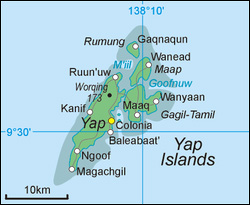CDC In the News
Investigators Determine Zika Virus Cause of Outbreak on Yap Islands
Published: June 28, 2007

The Yap Islands, or Yap, comprised of four continental islands located in the Caroline Islands of the Federated States of Indonesia in the western Pacific Ocean. (Image by Aotearoa from Poland, GNU FDL)
CDC's disease investigators quickly determined the cause of an infectious disease outbreak on a chain of pacific islands with the help of scientists at the new Arbovirus Diagnostic Laboratory.
Currently, CDC has two Epidemic Intelligence Service (EIS) Officers investigating this outbreak of a dengue-like illness on the Yap Islands, Federated States of Micronesia.
Patient samples tested by CDC's Arbovirus Diagnostic Laboratory indicate the cause to be Zika virus (a flavivirus).
Zika is a mosquito-borne virus that is similar to dengue. It was first isolated in the Zika forest in Uganda, a country in Africa.
The number of cases is still being determined, but is likely to number in the hundreds. To date, there are no hospitalizations or deaths.
Clinical symptoms of this Zika outbreak are still being defined, but patients tend to have fever, conjunctivitis, transient arthritis/arthralgia, and rash.
Upon determining the cause of this outbreak, CDC notified the health authorities on Yap of the laboratory findings. Yap public health officials held a press conference and began control measures similar to those for dengue.

With a newly-obtained fiery red blood meal visible through her transparent abdomen, the now heavy female Aedes aegypti mosquito took flight as she left her host’s skin surface. (Photo by James Gathany)
According to Lyle Conrad, MD, MPH, Director of CDC's Division of Vector-Borne Infectious Diseases, "A lot of credit for the quick identification of the cause of the outbreak goes to the staff of the Arbovirus Diagnostic Laboratory and Surveillance and Epidemiology Activity of the Arbovirus Diseases Branch."
The outbreak in Yap reportedly started in April and peaked in late May. As of Friday (June 22, 2007), 73 patients who were processed by the outpatient department at Yap's public hospital exhibited at least two of the three symptoms of Zika fever.
With the identification of Zika virus, the epidemiologic investigation focus has shifted from case characterization and case counting to planning and implementing a serosurvey.
Serosurveys have demonstrated Zika virus infections have also occurred in other parts of Africa and in Southeast Asia west of Wallace's line in Malaysia. However, fewer than 40 cases exist in the medical literature and documented outbreaks are extremely rare.
The National Center for Zoonotic, Vector-Borne, and Enteric Diseases (NCZVED) in Fort Collins is heading up the epidemiologic investigation. Additional clinical samples are en route to Fort Collins.
No cases have been reported in Guam but the Guam Department of Public Health and Social Services has advised residents to use mosquito netting over beds and to keep homes free from litter and standing water—such as the water that accumulates in saucers under potted plants—where mosquitoes may breed.
CDC scientists are continuing to conduct a joint investigation of this outbreak with Yap public health officials, the Federated States of Micronesia, and the World Health Organization (WHO).
Content source: Centers for Disease Control and Prevention
